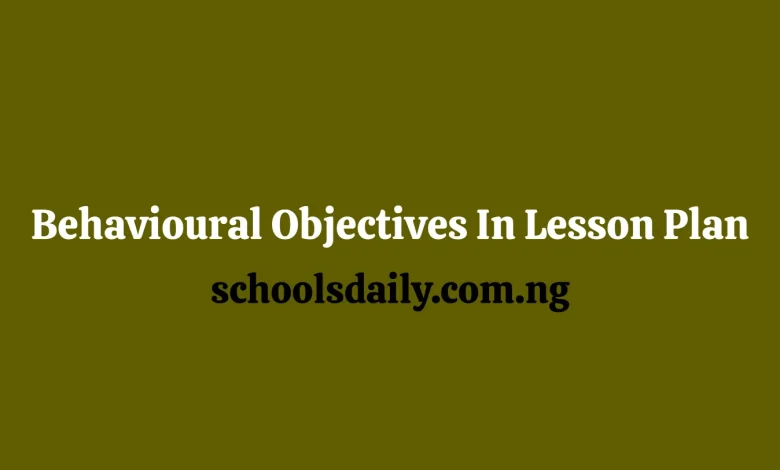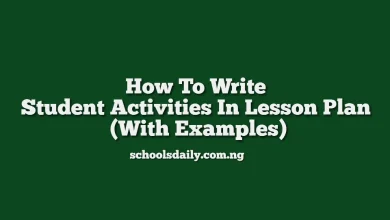Behavioural Objectives In Lesson Plan

This article explores Behavioral Objectives in lesson plans. If you’re a teacher or student teacher with little or no idea about effectively implementing behavioral objectives in your lesson plan, then this article is for you. You’re about to learn the meaning of Behavioral Objectives in lesson plans and how to implement them effectively. You’ll also discover definitions and examples of how Behavioral Objectives are written in a lesson plan.
What Is Behavioural Objectives In Lesson Plan
A behavioral objective is a statement that describes what a learner is expected to know or be able to do after completing a lesson or unit of instruction. These objectives are specific, measurable, and observable, enabling teachers to assess whether students have achieved the desired learning outcomes.
In essence, a behavioral objective outlines the anticipated learning outcomes at the end of a teaching and learning process. It is often referred to as the teacher’s target, defining what students should achieve after a lesson. Without clear objectives, teaching can be aimless, like traveling without a destination.
Moreover, behavioral objectives play a crucial role in evaluating the success of a lesson. When these objectives are transformed into questions and answered correctly, they indicate that the lesson has been delivered effectively.
When you write behavioral objectives, you need to remember these four key components:
- Audience: Think about who you are writing the objective for. Who are your learners? Consider their age, level of maturity, and the environment they’re in.
- Behavior: Use specific, action-oriented verbs that describe exactly what the learner should be able to do. For example, use words like “explain,” “define,” “analyze,” or “highlight.” Avoid vague terms like “understand” or “know,” because it’s hard to measure whether someone has achieved them.
- Condition: You should specify the conditions under which the behavior will be performed. This often includes adding a time constraint. For instance, your objective might be tied to a specific time on the timetable or a certain amount of time for completion.
- Degree: Be specific about how well the learner must perform the behavior. State the level of mastery required. Instead of a vague statement, you can provide clear criteria, such as “list five examples” or “correctly answer 8 out of 10 questions.”
Focus of Behavioral Objectives
In the process of creating lesson objectives, you should focus on the Blooms Taxonomy which organizes learning into three main areas, or “domains.”
- Cognitive Domain: This domain is all about intellectual learning. It includes things like gaining knowledge, processing information, solving problems, and making predictions. This is where students use their brains to understand and apply new concepts.
- Affective Domain: This domain covers a student’s feelings, attitudes, values, and emotions. Learning in this area can range from simply becoming aware of something to developing a strong sense of acceptance or engagement.
- Psychomotor Domain: This is the physical learning domain. It involves skills that require using and coordinating muscles, such as writing, drawing, or lifting.
How To Write Behavioural Objectives In Lesson Plan
Before you begin writing behavioral objectives for your lesson plan, you should aim to have at least three objectives. This is a good practice to ensure you cover all three domains of Bloom’s Taxonomy, which we discussed earlier.
You can start writing your behavioral objectives using one of these two phrases:
“By the end of the lesson, the students will be able to:”
“At the end of the lesson, the pupils should be able to…”
Both phrases are correct, but the first one, “By the end of the lesson, the students will be able to,” is generally considered more suitable and is widely used in educational settings.
Examples Behavioural Objectives In Lesson Plan
A great way to understand how to write behavioral objectives is to look at some concrete examples and see how they apply the principles you just learned.
Here are your examples, explained more clearly:
Example I: Transportation
For a lesson on transportation, your objectives should cover different types of learning.
By the end of the lesson, students will be able to:
- Define transportation.
This is a Cognitive objective. You are asking students to use their knowledge to recall a definition. The action verb here is “define.”
- Mention three types of transportation.
This is also a Cognitive objective, as students are recalling and listing information. The action verb is “mention,” and the specific degree is “three.”
- Draw a motorcycle.
This is a Psychomotor objective, as it requires a physical skill. The action verb is “draw.”
Example II: Farm Produce
By the end of the lesson, the students will be able to:
- Define farm produce.
This is a Cognitive objective, focusing on the recall of knowledge.
- List four examples of farm produce.
This is another Cognitive objective, with the action verb “list” and the specific degree of “four.”
- Demonstrate proper handling of a specific farm produce item, like washing or peeling.
This is a Psychomotor objective. The action verb is “demonstrate.” The condition is a specific farm produce item, and the degree is “properly.” This objective ensures students develop a practical skill.
Example III: My Community
For a lesson on “My Community,” you could include an affective objective to encourage personal values and appreciation.
By the end of the lesson, students will be able to:
List three important places in their community.
This is a Cognitive objective, as it requires the students to recall information.
- Draw a map of their neighborhood.
This is a Psychomotor objective, requiring a physical skill.
- Express appreciation for the work of community helpers.
This is an Affective objective. It focuses on developing a value (appreciation) and a positive feeling towards others. The action verb “express” requires the student to show their feelings or attitude.
These examples show how you can create a comprehensive lesson by setting objectives that target different learning types—from understanding and listing facts to performing physical tasks.



